The Iaido Newsletter January 2000
It is almost a truism in Japanese martial arts that power comes from the floor through the hips. In iaido that power must reach the tip of the blade, and the only connection between the tip and the floor is through the hands. In this series we examine some ways one can grip the sword during an iaido kata.
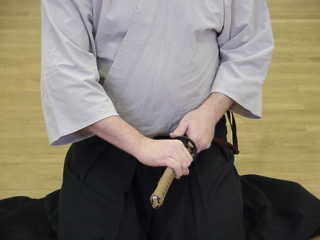 Here
in figure 1 (put your cursor over the figure to read the numbers) we have
what seems to be a good grip on the tsuka, and the student pulling the
blade from the saya. It doesn't look too bad until we analyse the lines
of force from the grip to the floor. Take a look at the right elbow, it
is out away from the body, now think about how one would make the tsuka
move forward if someone had their hand on the tsuka kashira (pommel). The
effort to move the tsuka would be through the deltoid in the shoulder,
and no amount of straining from the hips would help.
Here
in figure 1 (put your cursor over the figure to read the numbers) we have
what seems to be a good grip on the tsuka, and the student pulling the
blade from the saya. It doesn't look too bad until we analyse the lines
of force from the grip to the floor. Take a look at the right elbow, it
is out away from the body, now think about how one would make the tsuka
move forward if someone had their hand on the tsuka kashira (pommel). The
effort to move the tsuka would be through the deltoid in the shoulder,
and no amount of straining from the hips would help.
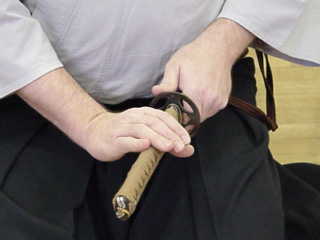 Now
look at this grip (fig. 2), the right hand is at a different angle, and
the elbow is close to the body. The tsuka is being pushed forward rather
than being pulled and the hips can now contribute to that forward motion.
Note that the grip on the tsuka is very light with the little finger and
mostly done with the two fingers closest to the body. Note in the first
figure (1) that the little finger is wrapped and trying to grip the blade.
This is as we normally teach, grip with the little and ring fingers, but
it is not correct in this case. We should teach a grip with the fingers
closest to the body, in this case, the index and middle fingers. We'll
call this second grip the index finger grip and the first one the
little finger grip.
Now
look at this grip (fig. 2), the right hand is at a different angle, and
the elbow is close to the body. The tsuka is being pushed forward rather
than being pulled and the hips can now contribute to that forward motion.
Note that the grip on the tsuka is very light with the little finger and
mostly done with the two fingers closest to the body. Note in the first
figure (1) that the little finger is wrapped and trying to grip the blade.
This is as we normally teach, grip with the little and ring fingers, but
it is not correct in this case. We should teach a grip with the fingers
closest to the body, in this case, the index and middle fingers. We'll
call this second grip the index finger grip and the first one the
little finger grip.
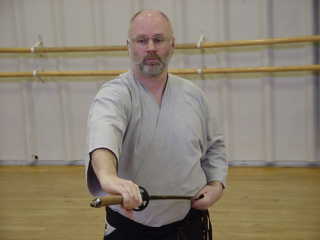 Here
is the finish of the draw from the saya (at saya banari) using the grip
with the little finger. Again, it doesn't look too bad until we compare
it with the next photo, of the grip with the index finger. In both photos
the blade is at the same angle but the elbows are not the same at all.
Look at the wrist and shoulders, in the first photo they are rolled upward
so as to grip the tsuka, in the second they are down and once more in a
position to push forward. It would be quite a difficult thing to topple
the student in the second photo (Figure 4) by pushing on the kashira, but
no big thing to push the student over onto his back in the little finger
grip (Figure 3).
Here
is the finish of the draw from the saya (at saya banari) using the grip
with the little finger. Again, it doesn't look too bad until we compare
it with the next photo, of the grip with the index finger. In both photos
the blade is at the same angle but the elbows are not the same at all.
Look at the wrist and shoulders, in the first photo they are rolled upward
so as to grip the tsuka, in the second they are down and once more in a
position to push forward. It would be quite a difficult thing to topple
the student in the second photo (Figure 4) by pushing on the kashira, but
no big thing to push the student over onto his back in the little finger
grip (Figure 3).
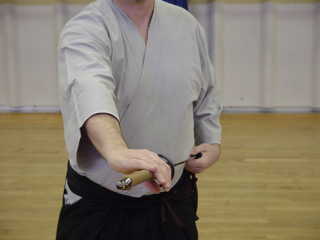
Here is a close-up of the hand position in Figure 4. 
Very well, let's consider that we are practicing the first kata (Mae) of ZenKenRen Iai (the Kendo Fedaration iai set) and continue on to the completed nuki tsuke position. Starting from the little finger grip we see the position in figure 6.
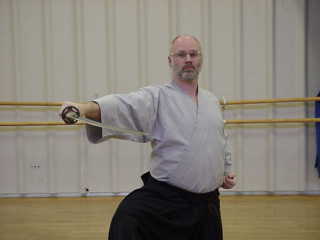 Not bad, the tip is in front of the right shoulder, and at nipple height,
the chest is turned 45 degrees to the left, the saya is pulled well around.
All in all not a bad position.
Not bad, the tip is in front of the right shoulder, and at nipple height,
the chest is turned 45 degrees to the left, the saya is pulled well around.
All in all not a bad position.
Once again, compare the little finger grip of figure 7 with figure 8,
the end result of the index finger grip.
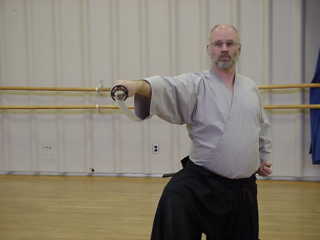
Hmm, the tip seems to be a lot further forward in this photo. How can that be, all the other body positions are the same, tip in front of shoulder, chest turned 45 degrees, saya well turned. The difference of course is in the grip.
Here is the grip at the end of the nuki tsuke using the little finger grip to begin (fig 8).
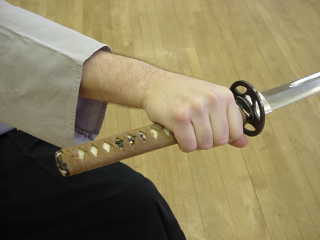
Compared to the grip with the index finger (fig 9).
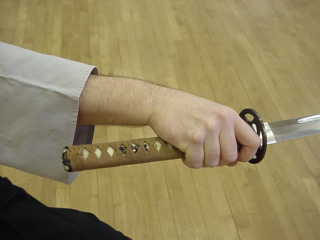 Figure
8 shows quite a square grip of the tsuka, and a large angle between the
forearm and the blade. Figure 9 shows how the tip ends up so much further
forward in the index finger grip. The loose little finger of the second
grip has pulled the tsuka much further into the palm. Figure 9 shows the
now correct "little finger grip" which we usually teach. (As opposed to
the incorrect little finger grip during nuki tsuke.)
Figure
8 shows quite a square grip of the tsuka, and a large angle between the
forearm and the blade. Figure 9 shows how the tip ends up so much further
forward in the index finger grip. The loose little finger of the second
grip has pulled the tsuka much further into the palm. Figure 9 shows the
now correct "little finger grip" which we usually teach. (As opposed to
the incorrect little finger grip during nuki tsuke.)
So, by teaching the students to push the tsuka out of the saya, rather
than pulling it out, we end up with the correct grip at the end of nuki
tsuke. There should be no need to change this right hand position for the
rest of the kata until the noto.
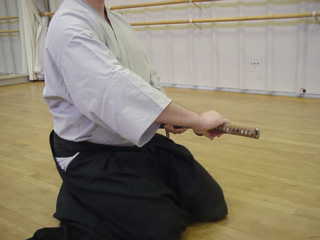
To recap, a little finger grip like figure 10 will result in a square,
full finger-gripped nuki tsuke like figure 6.
While a grip like figure 11 will result in a nuki tsuke like figure 7 with the little fingers tight, and the index finger loose.
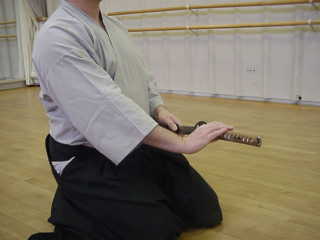
Take a moment and compare the shoulders and elbows of these last two figures. Note the angle of the elbow in each, and visualize what would happen if you were to push back on the tsuka kashira in each case. Still not convinced, look again at the rounded back of figure 10, and the off-square chest, compare that to the straight back in figure 11 and the squared chest. One is dead, one gives a feeling of power, even in the relaxed pose used here for the photographs.
If you were a knowledgeable swordsman (as you are now), which grip would give you most pause were you to be within range of the blade?
In the next article we will examine the grip for the cut.
Iaito for this article supplied by: Fujiwara Kanefusa